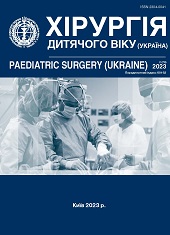Advantages of tangential excision with simultaneous autodermoplasty for treating burn wounds
DOI:
https://doi.org/10.15574/PS.2023.79.23Keywords:
burn injury, tangential excision, simultaneous autodermoplasty, treatmentAbstract
Burn trauma remains an important health problem, among which thermal burns of the limbs are one of the most common and complex due to the need to restore limb function and reduce aesthetic defects. Early tangential excision with simultaneous autodermoplasty is a complex technique that is also a significant stress for the patient, but it allows achieving all the set goals.
Purpose - to evaluate the effectiveness of tangential excision with simultaneous autodermoplasty for treating burn wounds compared to the classical method of treatment.
Materials and methods. The study included 24 patients with burns of the upper and/or lower limbs, from which two groups were formed: an experimental group (12 patients) and a control group (12 patients) who were equal in terms of patient sex, age, etiology of burn wounds, affected area. Tangential excision with simultaneous autodermoplasty was applied to patients in the experimental group, while delayed sequential necrectomy, xenoplasty (if necessary), and delayed autodermoplasty were performed on patients in the control group.
Results. Patients in the experimental group stayed in the hospital for an average of 10.5±4.5 days, which was almost half as long as in the control group (20.2±3.5 days). The number of surgical interventions in the experimental group was 1.3±0.5 operations, while in the control group it was 2.7±0.8 operations, and the number of general anesthesia procedures in the experimental group was significantly lower (1.3±0.5) than in the control group (4.6±1.1; p<0.05). In the experimental group, the number of dressings for each injury was 4.3±1.6, while in the control group it was almost three times as many (12.7±3.0; p<0.05). The duration of healing of burn wounds in the experimental group was 13.3±4.3 days, which was shorter than in the control group (24.2±3.9 days; p<0.05). The prevalence rate of infectious complications in the experimental group was 21.1% (4 cases), while in the control group it was significantly higher (58.8%). However, the prevalence rate of other complications, such as lysis of skin grafts, was only slightly lower in the experimental group (15.8%, or 3 cases) compared to the control group (29.4%, or 5 cases). 2 (18.2%) burn wounds in the experimental group required secondary reconstruction, while in the control group, 7 (70.0%) wounds required it.
Conclusions. Treatment of burn wounds of the upper and/or lower limbs using the method of tangential excision with simultaneous autodermoplasty allows for a reduction in the length of hospital stay, a decrease in the number of surgical interventions, general anesthesia procedures, dressing changes, and ensures faster wound healing, as well as reduces the frequency of complications and the need for secondary reconstruction.
The research was carried out in accordance with the principles of the Helsinki Declaration. The study protocol was approved by the Local Ethics Committee of all participating institutions. The informed consent of the patient was obtained for conducting the studies.
No conflict of interests was declared by the authors.
References
Badr MLA, Keshk TF, Alkhateeb YM, El Refaai EAM. (2019). Early excision and grafting versus delayed grafting in deep burns of the hand. Int Surg J. 6 (10): 3530-3535. https://doi.org/10.18203/2349-2902.isj20194404
Farmaha TI, Lukavetskyy ОV, Chemerys OM. (2022). Computer-assisted digital planimetry of wounds of various origins. Hospital Surgery. Journal Named by L.Ya. Kovalchuk. 3: 42-45.
Greenhalgh DG. (2019). Management of Burns. New Engl J Med. 380: 2349-2359. https://doi.org/10.1056/NEJMra1807442; PMid:31189038
Klein MB, Hunter S, Heimbach DM, Engrav LH, Honari S, Gallery E, Kiriluk DM, Gibran NS. (2005). The Versajet water dissector: a new tool for tangential excision. J Burn Care Rehabil. 26 (6): 483-487. https://doi.org/10.1097/01.bcr.0000185398.13095.c5; PMid:16278562
Lanham JS, Nelson NK, Hendren B, Jordan TS. (2020). Outpatient Burn Care: Prevention and Treatment. Am Fam Physician. 101 (8): 463-470.
Shao F, Ren WJ, Meng WZ, Wang GZ, Wang TY. (2018). Burn Wound Bacteriological Profiles, Patient Outcomes, and Tangential Excision Timing: A Prospective, Observational Study. Ostomy Wound Manage. 64 (9): 28-36. https://doi.org/10.25270/owm.2018.9.2836
Sharma DJ, Langer V. (2019). Management of hand burns using tangential excision and grafting versus delayed excision and grafting. Int Surg J. 6 (6): 2097-2103. https://doi.org/10.18203/2349-2902.isj20192374
World Health Organization. (2022). Fact Sheet. Accessed on 26 February 2022. URL: https://www.who.int/news-room/fact-sheets/detail/burns.
Downloads
Published
Issue
Section
License
Copyright (c) 2023 Paediatric Surgery (Ukraine)

This work is licensed under a Creative Commons Attribution-NonCommercial 4.0 International License.
The policy of the Journal “PAEDIATRIC SURGERY. UKRAINE” is compatible with the vast majority of funders' of open access and self-archiving policies. The journal provides immediate open access route being convinced that everyone – not only scientists - can benefit from research results, and publishes articles exclusively under open access distribution, with a Creative Commons Attribution-Noncommercial 4.0 international license(СС BY-NC).
Authors transfer the copyright to the Journal “PAEDIATRIC SURGERY.UKRAINE” when the manuscript is accepted for publication. Authors declare that this manuscript has not been published nor is under simultaneous consideration for publication elsewhere. After publication, the articles become freely available on-line to the public.
Readers have the right to use, distribute, and reproduce articles in any medium, provided the articles and the journal are properly cited.
The use of published materials for commercial purposes is strongly prohibited.

